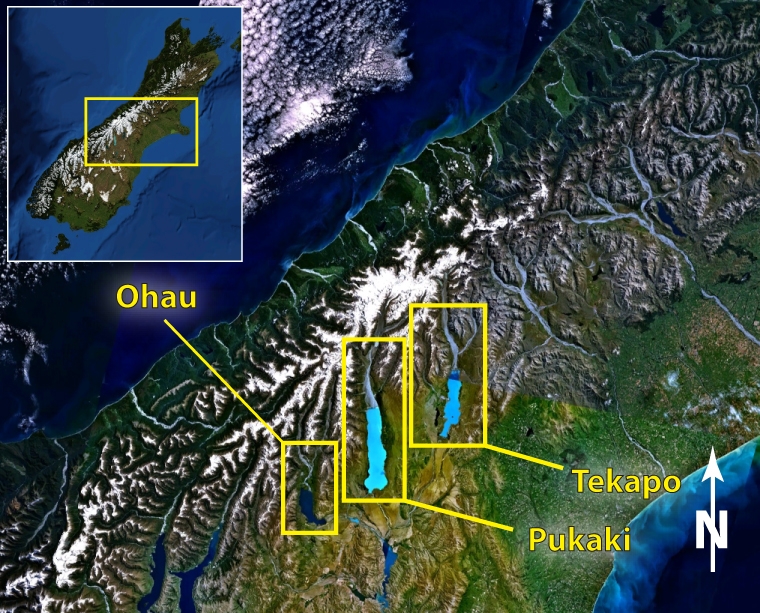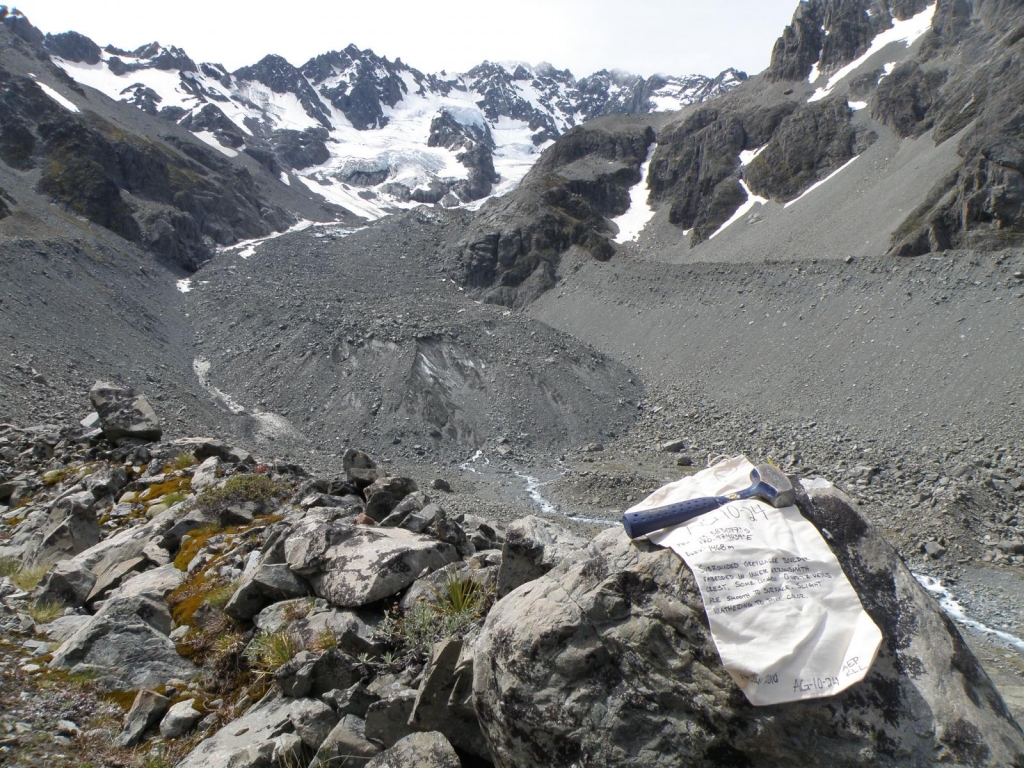
Glacier History of the New Zealand Southern Alps
Glacier History of the New Zealand Southern Alps
Personnel: George H. Denton
Graduate students: Aaron E. Putnam (Ph.D. candidate), Kathryn L. Ladig (M.S. student), Alice M. Doughty (M.S., now at Victoria University of Wellington), Samuel E. Kelley (M.S., now at University of Buffalo)
Collaborators: Dr. Joerg M. Schaefer (Columbia University), Dr. Michael R. Kaplan (Columbia University), Mr. David J.A. Barrell (GNS Science), Professor Bjørn G. Andersen (University of Oslo), Dr. Marcus Vandergoes (GNS Science), Professor Christian Schlüchter (Bern), Dr. Robert Finkel (Lawrence-Livermore National Laboratory)
Late Pleistocene ice ages comprise the greatest fluctuations in Earth’s climate over the last one million years. Each ice age began gradually and ended abruptly in what have been deemed glacial ‘terminations.’ Accompanying terminations were massive reorganizations of oceanic and atmospheric circulation, as well as near-doublings of atmospheric carbon dioxide. The last glacial termination occurred between ~18,000 and 11,500 years ago and constitutes the most pronounced climate change of the last 100,000 years. While these impressive changes form the underlying pulse of Earth’s climate over the last million years, we still do not understand why ice ages occur or why they end so spectacularly. To unravel the causes of the last ice age and the last great warming, we must know if these climate changes occurred synchronously across the planet, or if the hemispheres were anti-phased. The answer to this question has implications for understanding the underlying physics driving Earth’s climate system, and for deriving the sensitivity of the atmosphere to changes in carbon dioxide concentrations.
We study the glacier history of the Southern Alps of New Zealand in an effort to understand the global expression of the last ice age. New Zealand is at the antipode of the North Atlantic region, and is thus far from where the last great ice sheets rested at the height of the last ice age. The South Island lies at the northern fringe of the Southern Ocean, astride the sub-tropical convergence, and in the main path of the westerly winds. The Southern Alps support over 3000 glaciers at present. Being distal from Northern Hemisphere ice sheets and North Atlantic Ocean circulation removes the Southern Alps from feedbacks associated with those features; thus the glaciers of the Southern Alps are particularly sensitive to radiative forcings, such as atmospheric carbon dioxide and changes in incident solar radiation due to Earth’s wobble and tilt, as well as to surface temperatures of the Southern Ocean.
During the last ice age, glaciers had coalesced to form piedmont lobes that constructed an impressive array of landforms in the forelands of the Southern Alps. Moraines are ridges of debris formed at the terminus of a glacier; thus moraine ridges are useful for tracing the footprint of former glaciers on the landscape. With careful geomorphologic mapping we reconstruct the geometries of former glaciers of New Zealand. While the maps are yet to be published, an early form of the Central South Island Glacial Geomorphology (CSIGG) map can be viewed at http://maps.gns.cri.nz/website/csigg/. Glaciers of the Southern Alps respond in a straightforward manner to changes in atmospheric temperature, and thus their former extent, reconstructed from glacial geomorphology, can be used to quantify atmospheric palaeotemperatures using snowline reconstructions or glaciological modeling. We work closely with the Lamont-Doherty Earth Observatory Cosmogenic Nuclide Laboratory to develop robust chronologies of these moraine systems. We use the cosmogenic 10Be surface-exposure dating method to determine the age of each of each individual ice-marginal position by sampling the tops of boulders embedded in or resting on moraine crests. We extract the beryllium at the LDEO laboratory, and measure 10Be/9Be ratios at Lawrence-Livermore National Laboratory Center for Accelerator Mass Spectrometry. Recent breakthroughs in the 10Be method have led to a level of precision and accuracy that rivals the exactitude of radiocarbon dating, allowing us to date surfaces as old as millions of years and as young as one-hundred years. Together, our glacial geomorphologic and geochronological approach affords the opportunity to derive a detailed and robust temperature history of the Southern Alps from the last glacial period to historical times. With such a tool we can test drivers of Southern Hemisphere climate and approach a resolution to the problem of ice ages.
Relevant Publications:
Denton, G.H., Anderson, R.F., Toggweiler, J.R., Edwards, R.L., Schaefer, J.M., Putnam, A.E., 2010. The last glacial termination. In press at Science.
- Figure 1. Regional map of the central New Zealand Southern Alps. Lakes Ohau, Pukaki, and Tekapo are indicated by yellow boxes. These lakes were carved by former glaciers, and their catchments contain sequences of moraines that were deposited during and since the last ice ages. Most of our research is focused in the central Southern Alps catchments highlighted in this diagram.
- Figure 2. View north up the Pukaki valley toward Aoraki/Mount Cook. A large glacier occupied this valley during the last glacial maximum. The slope in the foreground is a moraine wall that was abandoned at the onset of the last glacial termination 18,350 ± 300 years ago (age is derived from the average of several 10Be ages; see Putnam et al., 2010). Photo: A. Putnam.
- Figure 3. View north toward the debris-covered snout of the Ashburton Glacier, Arrowsmith Range. Boulder in foreground is on moraine that was deposited at the culmination of the last major advance of the Ashburton Glacier. We sampled this boulder for 10Be surface-exposure dating. While we are still working on deriving the age of this moraine, similar moraines in adjacent valleys yield ages of ~500-600 yrs ago (see Schaefer et al., 2009). Photo: A. Putnam.
Figure 2. View north up the Pukaki valley toward Aoraki/Mount Cook. A large glacier occupied this valley during the last glacial maximum. The slope in the foreground is a moraine wall that was abandoned at the onset of the last glacial termination 18,350 ± 300 years ago (age is derived from the average of several 10Be ages; see Putnam et al., 2010). Photo: A. Putnam.
Figure 3. View north toward the debris-covered snout of the Ashburton Glacier, Arrowsmith Range. Boulder in foreground is on moraine that was deposited at the culmination of the last major advance of the Ashburton Glacier. We sampled this boulder for 10Be surface-exposure dating. While we are still working on deriving the age of this moraine, similar moraines in adjacent valleys yield ages of ~500-600 yrs ago (see Schaefer et al., 2009). Photo: A. Putnam.



